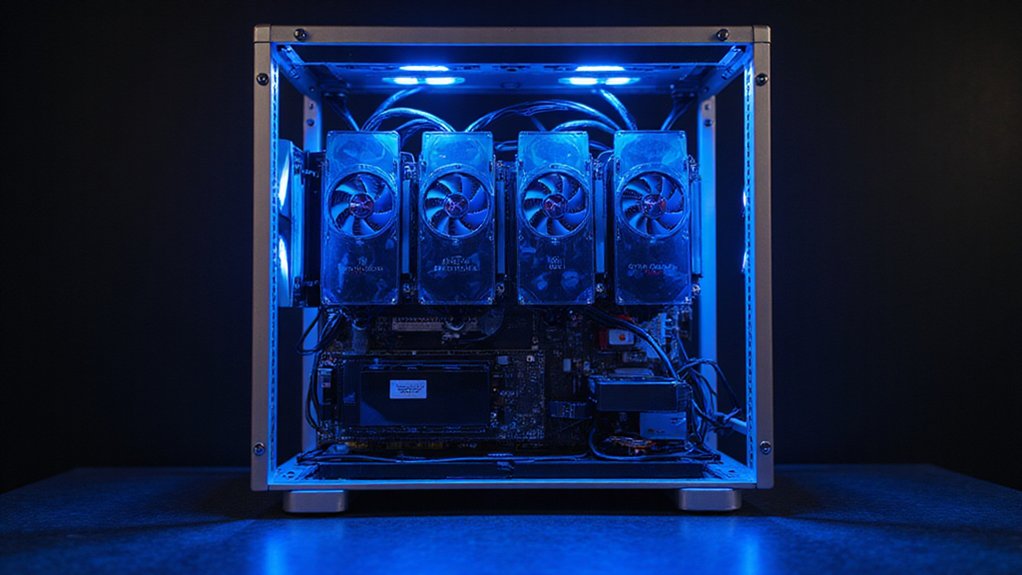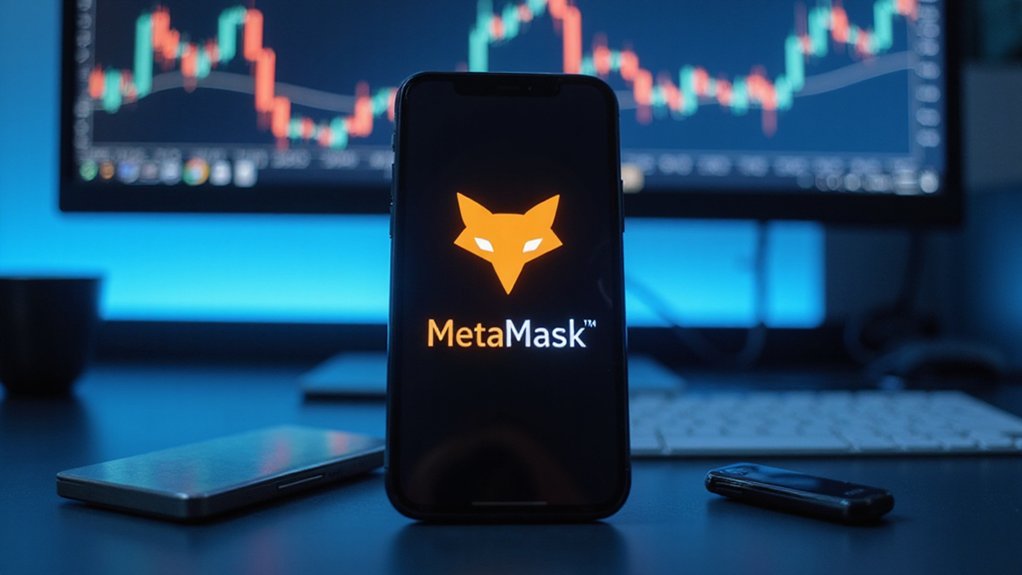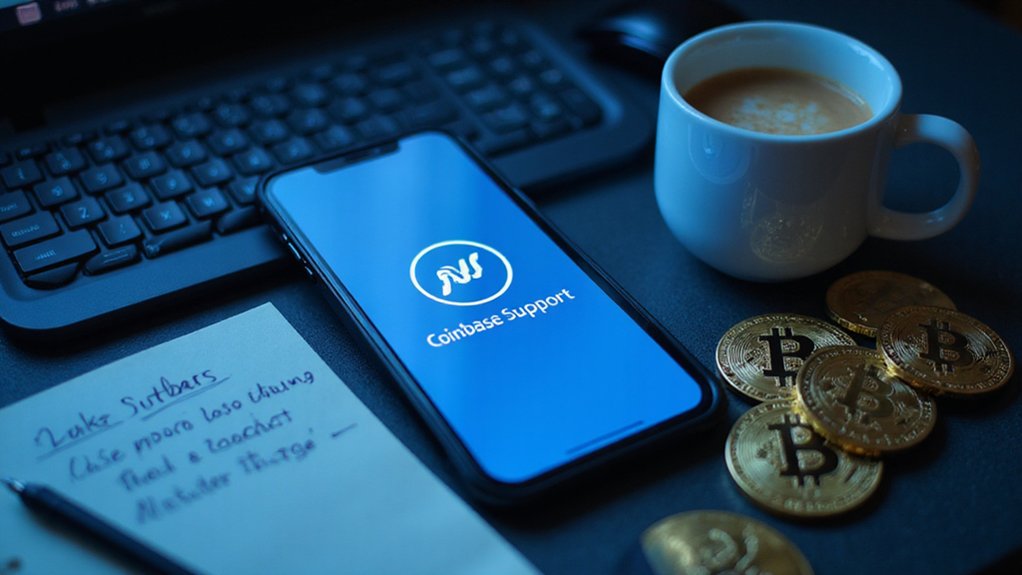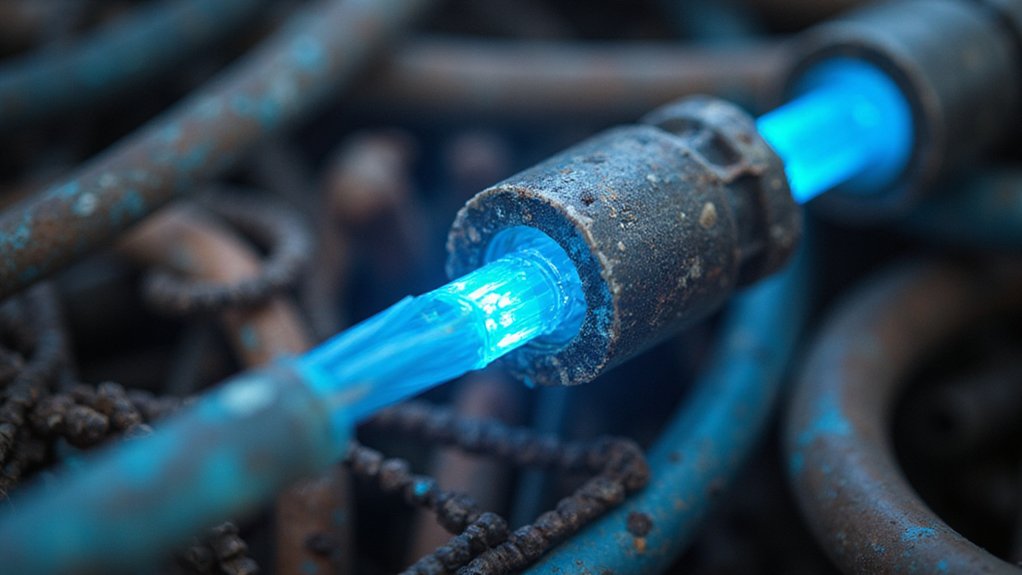Building a crypto mining rig requires strategic hardware selection—typically high-performance GPUs like the RTX 3080 mounted on mining-friendly motherboards such as the ASUS B250 Mining Expert. A robust 1300W+ power supply prevents system instability, while proper cooling arrangements (fans or liquid systems) maintain hardware longevity. Assembly involves mounting components on an open-air frame with adequate spacing for heat dissipation. Finally, configure a lightweight OS and specialized mining software like CGMiner. The subsequent financial viability, however, hinges on electricity costs versus crypto yields.

Why venture into the volatile world of cryptocurrency without understanding the fundamental architecture that underpins its acquisition?
Building a mining rig—essentially a specialized computer designed to validate blockchain transactions—requires methodical component selection and precise assembly techniques.
The foundation begins with high-performance GPUs (the Nvidia RTX 3080 offers particularly compelling hash rates), installed on a compatible motherboard like the ASUS B250 Mining Expert, which accommodates multiple graphics cards simultaneously. Miners choose GPUs over CPUs because they provide significantly better hash rate performance for solving complex cryptographic equations.
The power requirements of mining operations cannot be overstated; a robust PSU (minimum 1300W for multi-GPU setups) prevents system instability during peak processing periods. For ASIC miners like Antminer S19 or S21 series, specialized power supplies such as the APW12 with DC voltage range of 12V-15V are essential for optimal performance.
Unlike gaming rigs, mining setups can function with modest CPU and RAM specifications—these components merely orchestrate operations rather than perform computational heavy lifting.
Storage requirements remain similarly minimal, with a small SSD sufficient for operating system and mining software installation.
Assembly proceeds methodically: the motherboard attaches to a dedicated mining frame (often an open-air configuration to facilitate heat dissipation), followed by CPU and RAM installation.
GPUs mount to the motherboard via risers, creating adequate space between cards for airflow.
Cable management, frequently overlooked by novices, proves critical for preventing thermal complications and electrical hazards.
The software ecosystem includes a lightweight operating system (Linux distributions minimize overhead), specialized mining software such as CGMiner, and a secure cryptocurrency wallet for asset storage. The mining software constantly seeks the correct nonce value to solve the cryptographic puzzles that validate new blocks on the blockchain.
One must not underestimate cooling considerations—a combination of strategically placed fans, adequate ventilation, and potentially liquid cooling systems for high-density setups prevents premature hardware degradation.
Safety protocols demand meticulous attention: proper electrical connections, anti-static precautions during handling, temperature monitoring systems, and fire safety equipment nearby.
The completed rig requires configuration via mining software, where pool selection, wallet address input, and performance optimization occur.
Despite the initial complexity, a properly constructed mining rig represents both a technical achievement and a potential revenue stream—provided, of course, that electricity costs don’t render the entire enterprise financially untenable.
Frequently Asked Questions
How Much Electricity Will a Mining Rig Consume Monthly?
A standard mining rig with 1,000W power consumption operating continuously consumes approximately 720 kWh monthly (1kW × 24 hours × 30 days).
Factors affecting this baseline include GPU quantity, utilization rate (typically 80% of maximum capacity), and cooling requirements.
At average electricity rates ($0.12/kWh), operators face roughly $86 in monthly power costs—a sobering reality check for aspiring miners who, rather predictably, often underestimate this recurring expense when calculating potential profitability.
What Are the Tax Implications of Crypto Mining Income?
Crypto mining income triggers tax liability at the moment of receipt, with the fair market value establishing one’s basis.
Miners face a labyrinthine tax landscape: income tax on rewards, potential capital gains upon disposal, and—should the IRS deem the operation a business rather than hobby—self-employment taxes.
The business/hobby distinction proves vital; the former permits expense deductions while requiring Schedule C filing, whereas the latter relegates reporting to Schedule 1, without the deduction benefits.
Can I Mine Crypto Using Solar Power?
Mining crypto with solar power is technically feasible but economically challenging.
While it aligns perfectly with sustainability goals (eliminating 0.5-1kg CO2/kWh), the intermittent nature of sunlight necessitates substantial battery storage to support the 24/7 energy demands of mining equipment.
The economics improve in sun-rich regions like the Southwest US, where 6.5+ peak hours optimize ROI.
The substantial upfront investment in panels and batteries eventually pays off through eliminated utility costs—assuming Bitcoin’s price cooperates.
How Loud Are Mining Rigs During Operation?
Mining rigs generate substantial noise during operation, with ASIC miners producing 70-90 dB (comparable to nightclubs), while GPU setups operate at a more tolerable 30-40 dB.
Industrial cooling systems add another 80-100 dB to the acoustic profile.
The cumulative effect scales logarithmically—100 ASICs produce approximately 95 dB.
This explains the growing litigation from residential neighbors experiencing sleep disruption and potential hearing damage from prolonged exposure to these mechanical symphony conductors of the crypto world.
What Happens to Mining Profitability After Cryptocurrency Halving Events?
Halvings immediately slash mining revenue by 50%, triggering a predictable cascade of financial triage among operators—efficient players survive while marginal miners face extinction.
Profitability typically undergoes a J-curve effect: initial compression followed by expansion as market prices adjust upward over 12-18 months.
This evolutionary pressure repeatedly culls the ecosystem of inefficient miners, driving industry consolidation and technological advancement while paradoxically strengthening the network’s security through natural selection.









